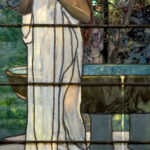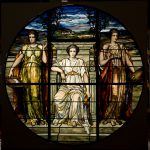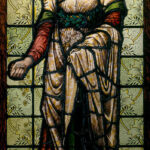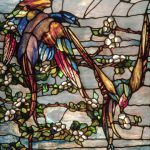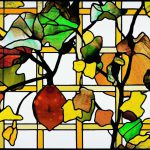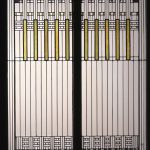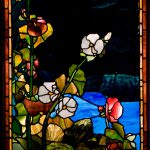In this era, only the wealthiest could afford the total unity of design created by such luminary decorators as Louis Comfort Tiffany or Frank Lloyd Wright. Although their work is included in this exhibition, neoclassical, neo-Gothic, and other revival-style decorative objects mix and mingle with those more avant-garde pieces thereby reflecting the eclecticism that truly characterized the visual environment of the latter nineteenth century.
The Arts window, c. 1894, by J. & R. Lamb Studios is the centerpiece of the exhibition. A prominent American glasshouse of the period, Lamb Studios exhibited this neoclassical window widely, and the Museum is pleased to present it for the first time in its galleries. The exhibition, organized from objects in the Museum’s collection, features more than twenty additional leaded-glass windows and panels as well as selections of art glass, pottery, and furniture. Besides works by Lamb, the windows on view—some avant-garde, others reviving styles of the past—include examples by Tiffany Studios, John La Farge, Frank Lloyd Wright, Edward Burne-Jones, Donald MacDonald, and Heaton, Butler & Bayne.
Revival & Reform is a homage to the diverse design of the period and the visually complex interiors in which most people of this time actually lived, but it is first and foremost an exhibit of splendidly beautiful works of art.
Following is information about objects and artists featured in the exhibition:
American Peachblow Glass
In 1886, the estate of Mary J. Morgan sold a Chinese porcelain vase associated with the Kangxi emperor (1654–1722) for $18,000. This event created such a sensation that glassmakers rushed to create their own versions to sell. An Englishman had patented the technique the same year. The Chinese porcelain had a famous blush-like glaze known as peach bloom, and American reproductions became popularly known as peachblow glass. Hobbs, Brockunier & Co. of Wheeling, West Virginia, led the market with a version it sold as Coral Ware. In Massachusetts, the Mount Washington Glass Company in Massachusetts then introduced its reproduction under the name Peach Blow and New England Glass Company’s debuted a version it called Wild Rose. Mount Washington’s Burmese ware, though a different formula, was similar in color. The company took the name from Queen Victoria (1819–1901), who described the grading of color on the glass to a Burmese sunset.
Donald MacDonald
Born in Glasgow, Scotland, Donald MacDonald (1841–1916) studied glass painting in London before immigrating to America in 1868. In 1872, MacDonald became a partner at Boston’s William J. McPherson & Co., and in 1876 opened a studio under his own name. MacDonald fabricated his own window designs as well as those by other notable designers. The Morse’s MacDonald window was made for the fashionable Gramercy Park home of Samuel Tilden (1814–86), the twenty-fifth governor of New York. MacDonald’s commission included a 200-square-foot leaded-glass dome for the library. The window was removed after the Tilden home was renovated in 1906 to house the National Arts Club.
Frank Lloyd Wright
Frank Lloyd Wright (1867–1959), greatly influenced by his mentor Chicago architect Louis Sullivan (1856–1924), was a leader in the Prairie School of architecture in the Midwest. He combined Arts and Crafts concepts with a deep reverence for Japanese simplicity and the flat plains of the local landscape. His truly American style was geometric, linear, and holistic. Employing transparent, uncolored glass in his windows, he fully integrated his interior environments with their natural exterior settings. One of Wright’s clients was Darwin D. Martin (1865–1935), an executive at the Larkin Soap Company in Buffalo, New York, and one of the highest paid men of his time. The geometry of Wright’s sideboard panels for the Martin house creates a strong vertical emphasis and reduces ornament to simple components.
Heaton, Butler & Bayne
Founded in 1855 by a glass painter, Clement Heaton (1824–82), and a lead glazier, James Butler (1830–1913), and joined in 1862 by a Pre-Raphaelite artist, Robert Turnill Bayne (1837–1915), Heaton, Butler & Bayne of London became one of the leading stained-glass producers in the world. Bayne’s extraordinary linear designs were translated using Heaton’s vast palette of colors, which he developed through studies of medieval glass. The company’s work combined the traditions of the Gothic Revival with the vivid colors and textural effects of the Pre-Raphaelites.
J. & R. Lamb Studios
In 1857, Joseph (1833–98) and Richard Lamb (1836–1909)—the British-born sons of a landscape architect— opened a stained-glass studio in New York’s Greenwich Village. Highly successful, the firm passed to Joseph’s sons, Charles Rollinson Lamb (1860–1942) and Frederick Stymetz Lamb (1863–1928) in 1885. The company became the longest continuously running stained-glass and ecclesiastical art maker in the country and remained in the Lamb family until acquired by an employee in 1970. The Arts window, exhibited widely in its time, depicts three classically robed idealized female figures on a classically styled stage. The landscape in the background recalls the classicism of the Renaissance. Each figure represents a category of art: the figure on the left represents textile art (needlepoint); the center figure, literature; and the figure on the right, painting.
John La Farge
John La Farge (1835–1910), was the first to patent opalescent glass on November 10, 1879. He eventually became Louis Comfort Tiffany’s major competitor. La Farge’s distinct style featured strong borders as well as compositional devices and brilliant colors inspired by the Japanese woodblock prints he collected. Like Tiffany, La Farge designed windows and murals for prominent public buildings, private homes, and churches. The Hollyhocks window is one of two La Farge made about 1890 from a painting he had done in 1863. One window was made for banker J. Pierpont Morgan (1837–1913), and the Morse window was made for financier and railroad magnate Michael Jenkins (1842–1915).
Louis Comfort Tiffany
Louis Comfort Tiffany (1848–1933), son of the silver and jewelry merchant Charles Tiffany (1812–1902), was one of the most creative and prolific designers of the late nineteenth century. Originally trained as a painter, he began studying the chemistry and techniques of glassmaking when he was twenty-four. He further developed this interest as one of the leading decorators of his day. In 1881, like his rival John La Farge, he registered a patent for opalescent window glass, a radical new treatment whereby several colors were combined and manipulated to create an unprecedented range of hues and three-dimensional effects. Though best known for his work in glass, Tiffany applied himself across the spectrum of decorative arts, introducing pottery in 1904.
William Morris
William Morris (1834–96) and his Morris & Co. were at the forefront of the British Arts and Crafts movement. Morris made everything from wallpaper to furniture. Edward Burne-Jones (1833–98), Morris’ design partner, was particularly noted for his work in stained-glass design. Morris and Burne-Jones looked to the English Middle Ages for inspiration and translated the visual effects and craftsmanship of the glass of that period into more modern designs. In its grace, simplicity, and literary roots, the Morse’s Flora window well represents their reform efforts. In 1890 Morris, a collector of medieval manuscripts, ventured into publishing books. The Works of Geoffery Chaucer: Now Newly Imprinted is one of the more important works printed by his Kelmscott Press. The decorative, intertwining foliage found along the border of his books emulated similar patterning found in medieval manuscripts.



